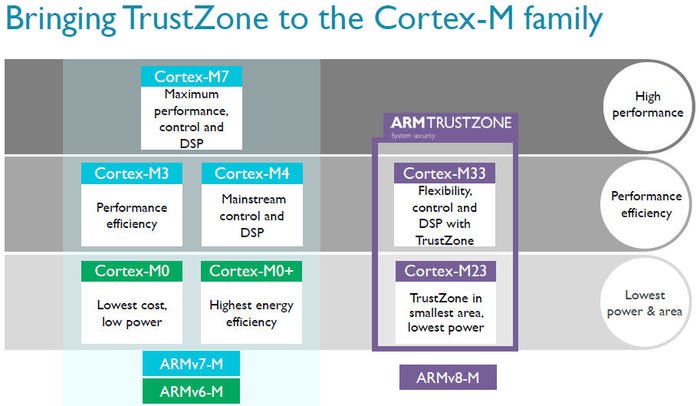Chip rivals ARM and Intel have both announced major new IoT launches at exactly the same time, opening a new front in their long-running war.
October 26, 2016

Chip rivals ARM and Intel have both announced major new IoT launches at exactly the same time, opening a new front in their long-running war.
ARM classifies its Cortex-branded chip designs according to their relative size and power. ‘A’ stands for ‘application processors’ such as the ones that provide the brains in smartphones. ‘R’ stands for ‘realtime’ and tends to apply to communications processors such as those found in modems. ‘M’ stands for ‘microcontroller’ and refers to the smallest chips, usually for embedded, industrial use.
It is at this end of the scale that ARM expects to extend its mobile dominance into the IoT market, by designing tiny, ultra-low power chips that can be embedded into billions of devices and provide them with smarts and connectivity.
The big launch was a new Cortex M family based on ARMv8-M architecture and apart from the usual core ARM claims about bang-per-buck/size/power, the special sauce seems to be the introduction of ARM TrustZone technology to this end of things.
TrustZone is a crypto-cell technology that essentially introduces security at the chip level. The benefits of having IoT chips with security built in should be obvious to anyone worried about IoT heralding an era of hackers hijacking smart devices and sending them rogue like some kind of real-life Fantasia.
“As IoT technologies become more pervasive, it is time for a complete solution that secures data from the sensor to the service,” said Pete Hutton, President of product groups at ARM. “ARM partners shipped a record 15 billion chips last year, many destined for smart embedded applications. The IoT already runs on ARM but the goal now is scale, which we are enabling today through a uniquely comprehensive set of technologies and services built to work together seamlessly.”

Intel, meanwhile, unveiled the E3900 series, which is positioned as an IoT chip but seems to be designed more for ‘fog computing’ – i.e. decentralising and distributing the cloud. So this is more of a low-power datacenter chip, rather than one designed for IoT devices.
It’s sensible for Intel to take this route to IoT as it’s probably never going to be able to compete with ARM on power efficiency so would lose a head-to-head battle in devices, just as it did in smartphones. Intel is the king of datacenters and hence the default chip-maker for the cloud. This launch seems to be designed to ensure Intel retains this position as fog computing becomes a thing.
“The Intel Atom processor E3900 series will make the edge and fog more intelligent – enabling many of the processing needs to take place at or near the data sensor and alleviating the need to push all processing to the data center,” blogged Intel. “Fog computing, also known as fog networking, is a decentralized computing infrastructure in which computing resources and application services are distributed in the most logical place at any point from the data source to the cloud.”
To show how serious it is about all this, Intel made a slick corporate video.
About the Author(s)
You May Also Like








.png?width=300&auto=webp&quality=80&disable=upscale)


_1.jpg?width=300&auto=webp&quality=80&disable=upscale)


.png?width=800&auto=webp&quality=80&disable=upscale)